Research Report: Impact of Pandemic on Students at Nelson College
VerifiedAdded on 2023/06/14
|32
|7226
|121
Report
AI Summary
This research report investigates the impact of the COVID-19 pandemic on college students, particularly focusing on changes in student interaction, the benefits of virtual learning environments, and the challenges of digital education. Using a theoretical research approach and a positivist research philosophy, the study employs a deductive research approach and questionnaire strategy to gather quantitative data. The literature review examines classroom interaction during the pandemic, advantages of virtual learning, barriers to effective digital education, and best teaching strategies for virtual environments. Key findings reveal the benefits of online learning in terms of increased retention and flexibility, as well as challenges related to student motivation, digital literacy among teachers, and technical difficulties. The report concludes by discussing the effectiveness of applied research methods, alternative methods, and lessons learned, providing insights into improving education in a virtual learning setting. The research also includes a proposal and ethics approval form.
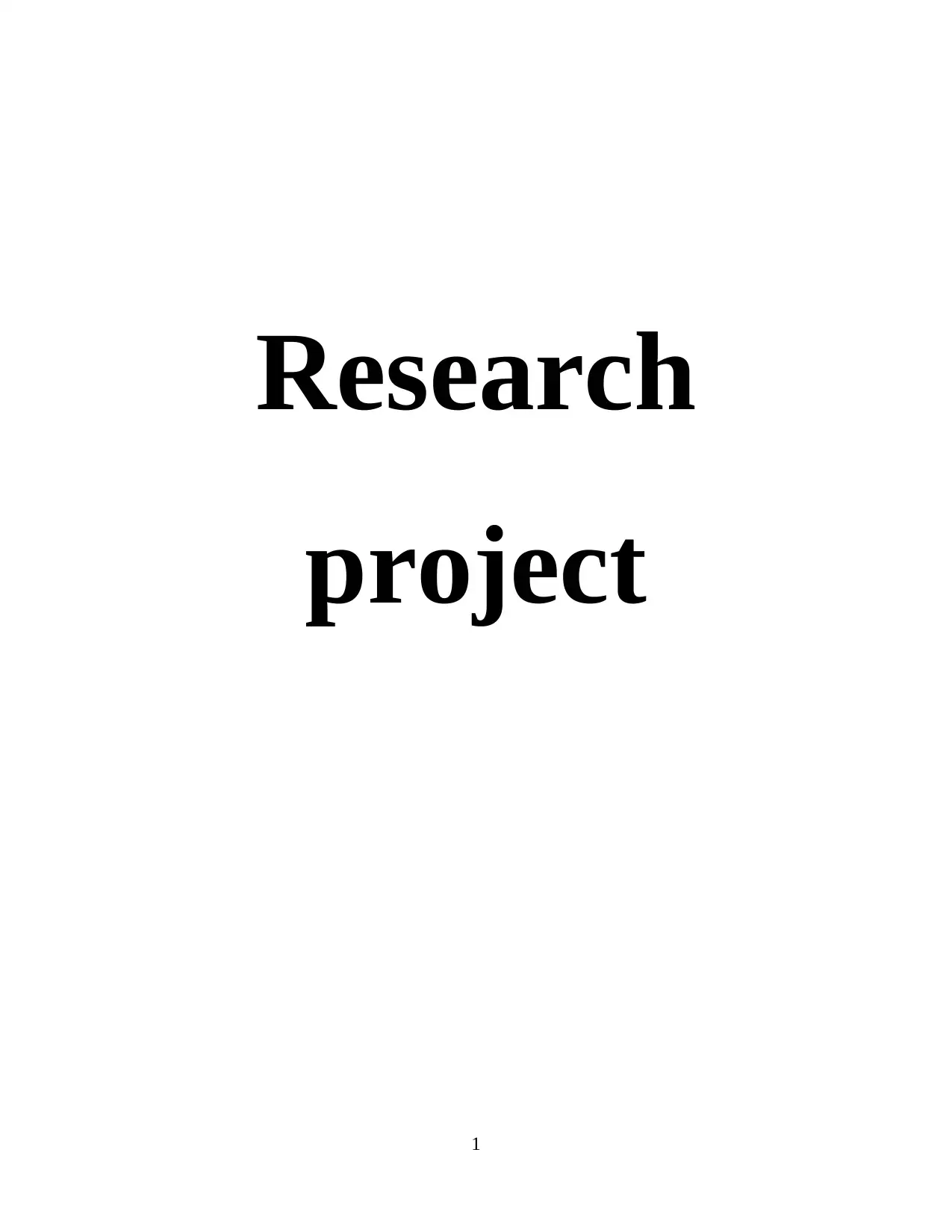
Research
project
1
project
1
Paraphrase This Document
Need a fresh take? Get an instant paraphrase of this document with our AI Paraphraser
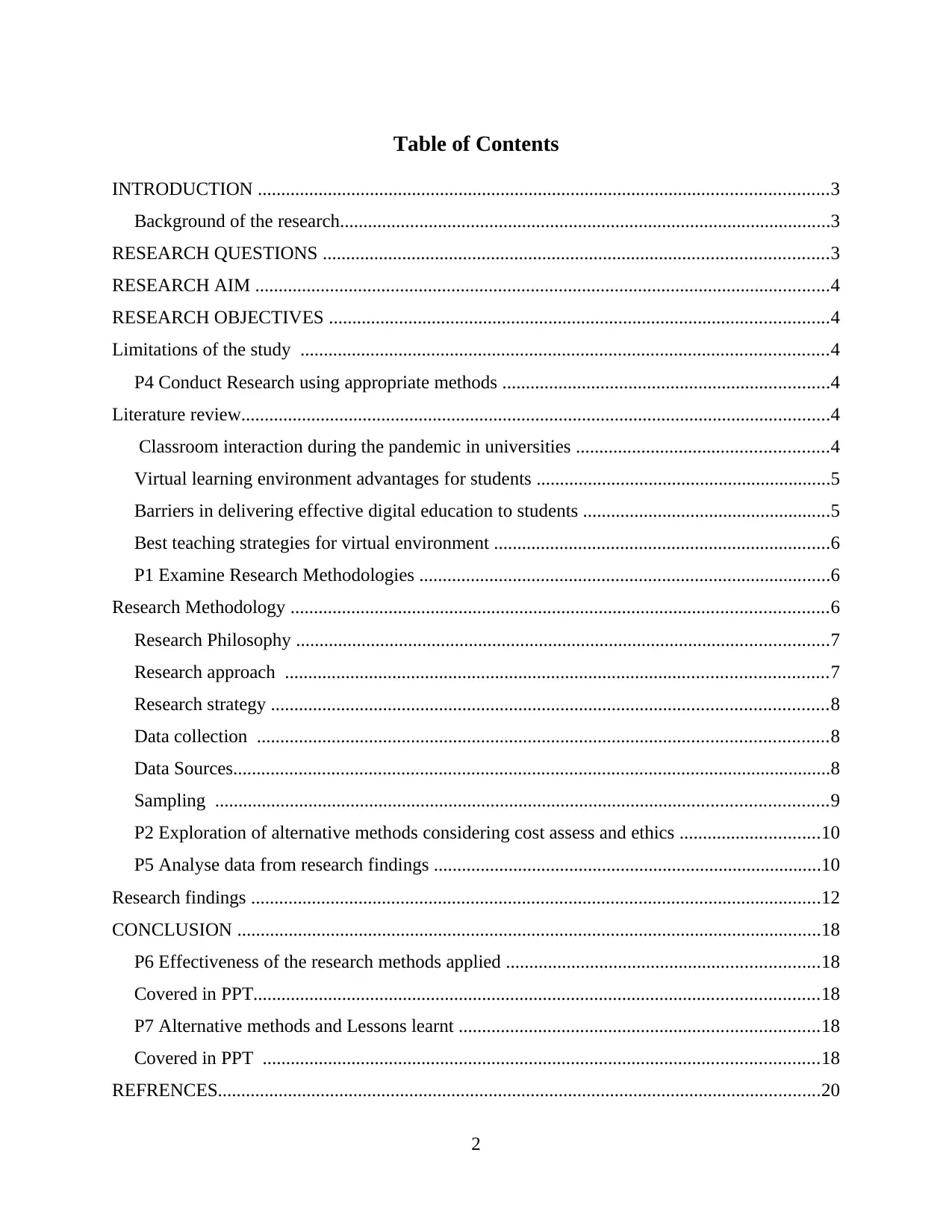
Table of Contents
INTRODUCTION ..........................................................................................................................3
Background of the research.........................................................................................................3
RESEARCH QUESTIONS ............................................................................................................3
RESEARCH AIM ...........................................................................................................................4
RESEARCH OBJECTIVES ...........................................................................................................4
Limitations of the study .................................................................................................................4
P4 Conduct Research using appropriate methods ......................................................................4
Literature review..............................................................................................................................4
Classroom interaction during the pandemic in universities ......................................................4
Virtual learning environment advantages for students ...............................................................5
Barriers in delivering effective digital education to students .....................................................5
Best teaching strategies for virtual environment ........................................................................6
P1 Examine Research Methodologies ........................................................................................6
Research Methodology ...................................................................................................................6
Research Philosophy ..................................................................................................................7
Research approach ....................................................................................................................7
Research strategy .......................................................................................................................8
Data collection ..........................................................................................................................8
Data Sources................................................................................................................................8
Sampling ...................................................................................................................................9
P2 Exploration of alternative methods considering cost assess and ethics ..............................10
P5 Analyse data from research findings ...................................................................................10
Research findings ..........................................................................................................................12
CONCLUSION .............................................................................................................................18
P6 Effectiveness of the research methods applied ...................................................................18
Covered in PPT.........................................................................................................................18
P7 Alternative methods and Lessons learnt .............................................................................18
Covered in PPT .......................................................................................................................18
REFRENCES.................................................................................................................................20
2
INTRODUCTION ..........................................................................................................................3
Background of the research.........................................................................................................3
RESEARCH QUESTIONS ............................................................................................................3
RESEARCH AIM ...........................................................................................................................4
RESEARCH OBJECTIVES ...........................................................................................................4
Limitations of the study .................................................................................................................4
P4 Conduct Research using appropriate methods ......................................................................4
Literature review..............................................................................................................................4
Classroom interaction during the pandemic in universities ......................................................4
Virtual learning environment advantages for students ...............................................................5
Barriers in delivering effective digital education to students .....................................................5
Best teaching strategies for virtual environment ........................................................................6
P1 Examine Research Methodologies ........................................................................................6
Research Methodology ...................................................................................................................6
Research Philosophy ..................................................................................................................7
Research approach ....................................................................................................................7
Research strategy .......................................................................................................................8
Data collection ..........................................................................................................................8
Data Sources................................................................................................................................8
Sampling ...................................................................................................................................9
P2 Exploration of alternative methods considering cost assess and ethics ..............................10
P5 Analyse data from research findings ...................................................................................10
Research findings ..........................................................................................................................12
CONCLUSION .............................................................................................................................18
P6 Effectiveness of the research methods applied ...................................................................18
Covered in PPT.........................................................................................................................18
P7 Alternative methods and Lessons learnt .............................................................................18
Covered in PPT .......................................................................................................................18
REFRENCES.................................................................................................................................20
2

APPENDIX ...................................................................................................................................20
P3 Research Proposal ...............................................................................................................20
RESREARCH PROPOSAL .........................................................................................................20
Research Ethics approval form......................................................................................................27
3
P3 Research Proposal ...............................................................................................................20
RESREARCH PROPOSAL .........................................................................................................20
Research Ethics approval form......................................................................................................27
3
⊘ This is a preview!⊘
Do you want full access?
Subscribe today to unlock all pages.

Trusted by 1+ million students worldwide
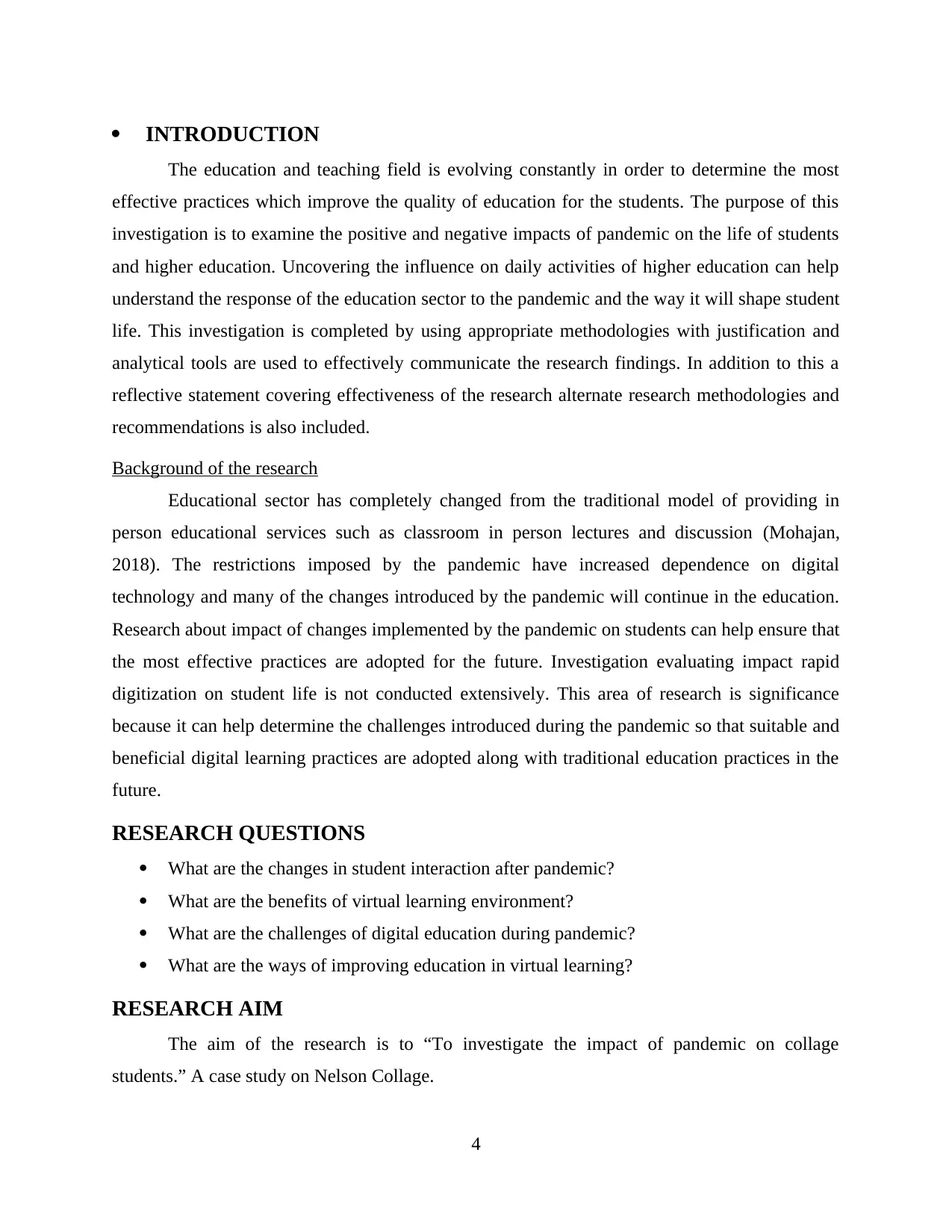
INTRODUCTION
The education and teaching field is evolving constantly in order to determine the most
effective practices which improve the quality of education for the students. The purpose of this
investigation is to examine the positive and negative impacts of pandemic on the life of students
and higher education. Uncovering the influence on daily activities of higher education can help
understand the response of the education sector to the pandemic and the way it will shape student
life. This investigation is completed by using appropriate methodologies with justification and
analytical tools are used to effectively communicate the research findings. In addition to this a
reflective statement covering effectiveness of the research alternate research methodologies and
recommendations is also included.
Background of the research
Educational sector has completely changed from the traditional model of providing in
person educational services such as classroom in person lectures and discussion (Mohajan,
2018). The restrictions imposed by the pandemic have increased dependence on digital
technology and many of the changes introduced by the pandemic will continue in the education.
Research about impact of changes implemented by the pandemic on students can help ensure that
the most effective practices are adopted for the future. Investigation evaluating impact rapid
digitization on student life is not conducted extensively. This area of research is significance
because it can help determine the challenges introduced during the pandemic so that suitable and
beneficial digital learning practices are adopted along with traditional education practices in the
future.
RESEARCH QUESTIONS
What are the changes in student interaction after pandemic?
What are the benefits of virtual learning environment?
What are the challenges of digital education during pandemic?
What are the ways of improving education in virtual learning?
RESEARCH AIM
The aim of the research is to “To investigate the impact of pandemic on collage
students.” A case study on Nelson Collage.
4
The education and teaching field is evolving constantly in order to determine the most
effective practices which improve the quality of education for the students. The purpose of this
investigation is to examine the positive and negative impacts of pandemic on the life of students
and higher education. Uncovering the influence on daily activities of higher education can help
understand the response of the education sector to the pandemic and the way it will shape student
life. This investigation is completed by using appropriate methodologies with justification and
analytical tools are used to effectively communicate the research findings. In addition to this a
reflective statement covering effectiveness of the research alternate research methodologies and
recommendations is also included.
Background of the research
Educational sector has completely changed from the traditional model of providing in
person educational services such as classroom in person lectures and discussion (Mohajan,
2018). The restrictions imposed by the pandemic have increased dependence on digital
technology and many of the changes introduced by the pandemic will continue in the education.
Research about impact of changes implemented by the pandemic on students can help ensure that
the most effective practices are adopted for the future. Investigation evaluating impact rapid
digitization on student life is not conducted extensively. This area of research is significance
because it can help determine the challenges introduced during the pandemic so that suitable and
beneficial digital learning practices are adopted along with traditional education practices in the
future.
RESEARCH QUESTIONS
What are the changes in student interaction after pandemic?
What are the benefits of virtual learning environment?
What are the challenges of digital education during pandemic?
What are the ways of improving education in virtual learning?
RESEARCH AIM
The aim of the research is to “To investigate the impact of pandemic on collage
students.” A case study on Nelson Collage.
4
Paraphrase This Document
Need a fresh take? Get an instant paraphrase of this document with our AI Paraphraser
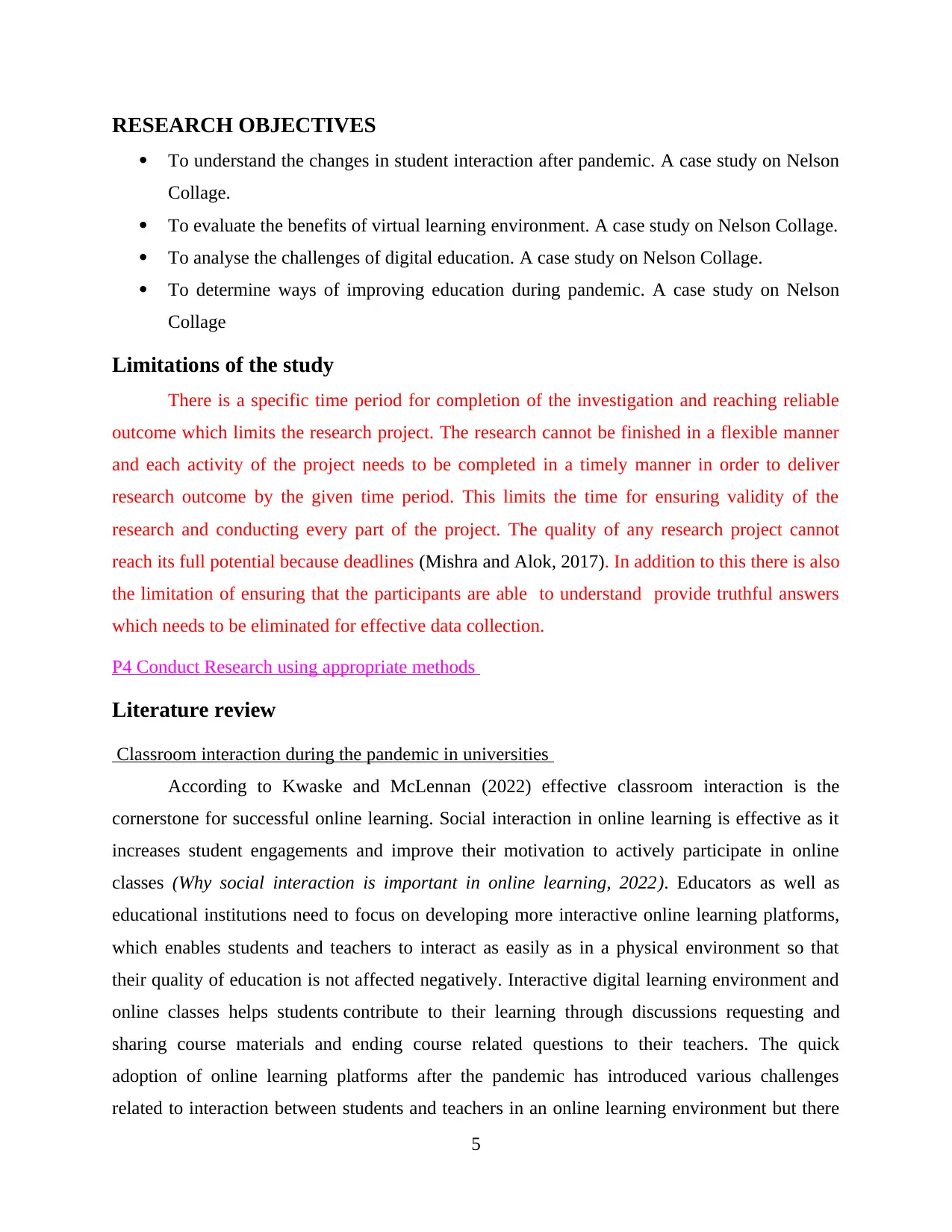
RESEARCH OBJECTIVES
To understand the changes in student interaction after pandemic. A case study on Nelson
Collage.
To evaluate the benefits of virtual learning environment. A case study on Nelson Collage.
To analyse the challenges of digital education. A case study on Nelson Collage.
To determine ways of improving education during pandemic. A case study on Nelson
Collage
Limitations of the study
There is a specific time period for completion of the investigation and reaching reliable
outcome which limits the research project. The research cannot be finished in a flexible manner
and each activity of the project needs to be completed in a timely manner in order to deliver
research outcome by the given time period. This limits the time for ensuring validity of the
research and conducting every part of the project. The quality of any research project cannot
reach its full potential because deadlines (Mishra and Alok, 2017). In addition to this there is also
the limitation of ensuring that the participants are able to understand provide truthful answers
which needs to be eliminated for effective data collection.
P4 Conduct Research using appropriate methods
Literature review
Classroom interaction during the pandemic in universities
According to Kwaske and McLennan (2022) effective classroom interaction is the
cornerstone for successful online learning. Social interaction in online learning is effective as it
increases student engagements and improve their motivation to actively participate in online
classes (Why social interaction is important in online learning, 2022). Educators as well as
educational institutions need to focus on developing more interactive online learning platforms,
which enables students and teachers to interact as easily as in a physical environment so that
their quality of education is not affected negatively. Interactive digital learning environment and
online classes helps students contribute to their learning through discussions requesting and
sharing course materials and ending course related questions to their teachers. The quick
adoption of online learning platforms after the pandemic has introduced various challenges
related to interaction between students and teachers in an online learning environment but there
5
To understand the changes in student interaction after pandemic. A case study on Nelson
Collage.
To evaluate the benefits of virtual learning environment. A case study on Nelson Collage.
To analyse the challenges of digital education. A case study on Nelson Collage.
To determine ways of improving education during pandemic. A case study on Nelson
Collage
Limitations of the study
There is a specific time period for completion of the investigation and reaching reliable
outcome which limits the research project. The research cannot be finished in a flexible manner
and each activity of the project needs to be completed in a timely manner in order to deliver
research outcome by the given time period. This limits the time for ensuring validity of the
research and conducting every part of the project. The quality of any research project cannot
reach its full potential because deadlines (Mishra and Alok, 2017). In addition to this there is also
the limitation of ensuring that the participants are able to understand provide truthful answers
which needs to be eliminated for effective data collection.
P4 Conduct Research using appropriate methods
Literature review
Classroom interaction during the pandemic in universities
According to Kwaske and McLennan (2022) effective classroom interaction is the
cornerstone for successful online learning. Social interaction in online learning is effective as it
increases student engagements and improve their motivation to actively participate in online
classes (Why social interaction is important in online learning, 2022). Educators as well as
educational institutions need to focus on developing more interactive online learning platforms,
which enables students and teachers to interact as easily as in a physical environment so that
their quality of education is not affected negatively. Interactive digital learning environment and
online classes helps students contribute to their learning through discussions requesting and
sharing course materials and ending course related questions to their teachers. The quick
adoption of online learning platforms after the pandemic has introduced various challenges
related to interaction between students and teachers in an online learning environment but there
5
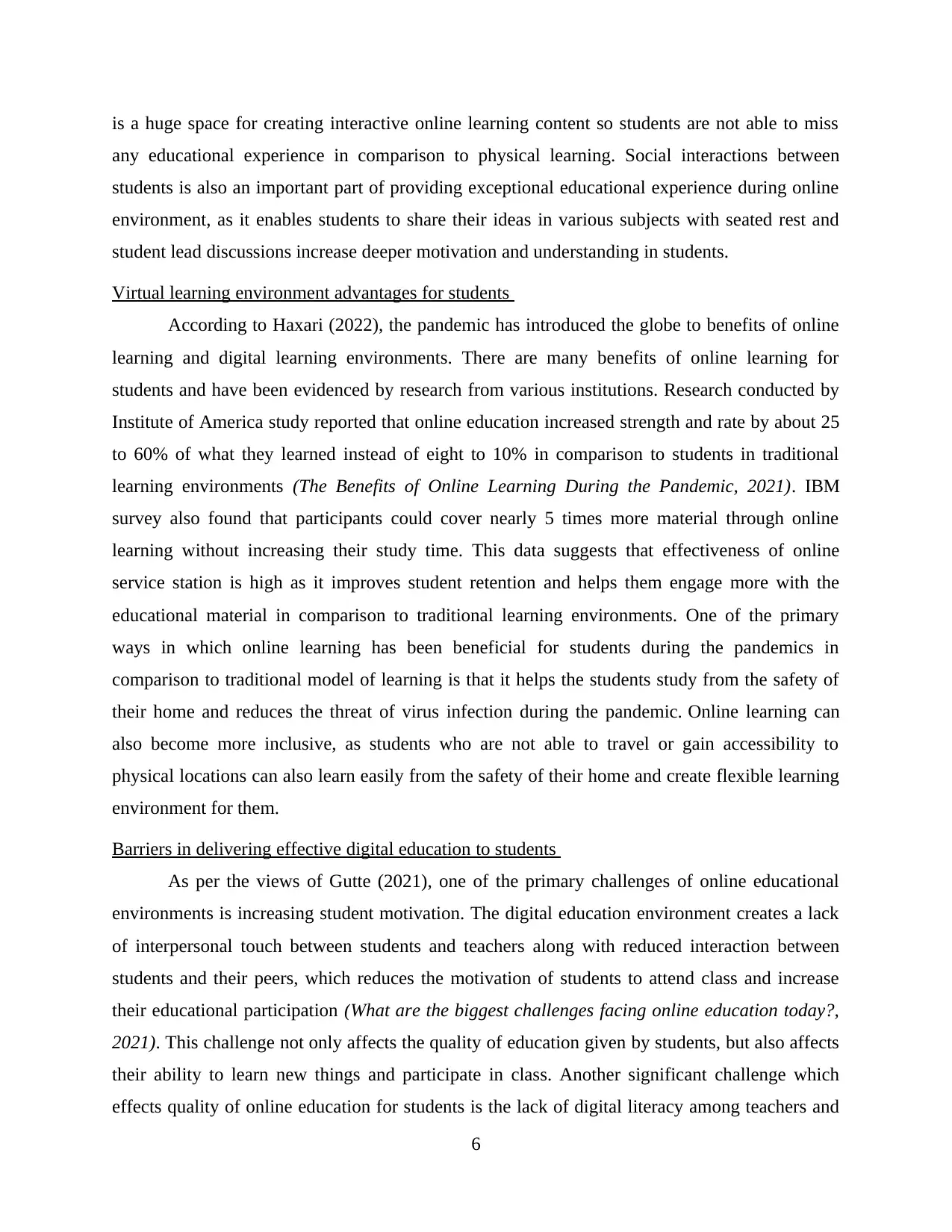
is a huge space for creating interactive online learning content so students are not able to miss
any educational experience in comparison to physical learning. Social interactions between
students is also an important part of providing exceptional educational experience during online
environment, as it enables students to share their ideas in various subjects with seated rest and
student lead discussions increase deeper motivation and understanding in students.
Virtual learning environment advantages for students
According to Haxari (2022), the pandemic has introduced the globe to benefits of online
learning and digital learning environments. There are many benefits of online learning for
students and have been evidenced by research from various institutions. Research conducted by
Institute of America study reported that online education increased strength and rate by about 25
to 60% of what they learned instead of eight to 10% in comparison to students in traditional
learning environments (The Benefits of Online Learning During the Pandemic, 2021). IBM
survey also found that participants could cover nearly 5 times more material through online
learning without increasing their study time. This data suggests that effectiveness of online
service station is high as it improves student retention and helps them engage more with the
educational material in comparison to traditional learning environments. One of the primary
ways in which online learning has been beneficial for students during the pandemics in
comparison to traditional model of learning is that it helps the students study from the safety of
their home and reduces the threat of virus infection during the pandemic. Online learning can
also become more inclusive, as students who are not able to travel or gain accessibility to
physical locations can also learn easily from the safety of their home and create flexible learning
environment for them.
Barriers in delivering effective digital education to students
As per the views of Gutte (2021), one of the primary challenges of online educational
environments is increasing student motivation. The digital education environment creates a lack
of interpersonal touch between students and teachers along with reduced interaction between
students and their peers, which reduces the motivation of students to attend class and increase
their educational participation (What are the biggest challenges facing online education today?,
2021). This challenge not only affects the quality of education given by students, but also affects
their ability to learn new things and participate in class. Another significant challenge which
effects quality of online education for students is the lack of digital literacy among teachers and
6
any educational experience in comparison to physical learning. Social interactions between
students is also an important part of providing exceptional educational experience during online
environment, as it enables students to share their ideas in various subjects with seated rest and
student lead discussions increase deeper motivation and understanding in students.
Virtual learning environment advantages for students
According to Haxari (2022), the pandemic has introduced the globe to benefits of online
learning and digital learning environments. There are many benefits of online learning for
students and have been evidenced by research from various institutions. Research conducted by
Institute of America study reported that online education increased strength and rate by about 25
to 60% of what they learned instead of eight to 10% in comparison to students in traditional
learning environments (The Benefits of Online Learning During the Pandemic, 2021). IBM
survey also found that participants could cover nearly 5 times more material through online
learning without increasing their study time. This data suggests that effectiveness of online
service station is high as it improves student retention and helps them engage more with the
educational material in comparison to traditional learning environments. One of the primary
ways in which online learning has been beneficial for students during the pandemics in
comparison to traditional model of learning is that it helps the students study from the safety of
their home and reduces the threat of virus infection during the pandemic. Online learning can
also become more inclusive, as students who are not able to travel or gain accessibility to
physical locations can also learn easily from the safety of their home and create flexible learning
environment for them.
Barriers in delivering effective digital education to students
As per the views of Gutte (2021), one of the primary challenges of online educational
environments is increasing student motivation. The digital education environment creates a lack
of interpersonal touch between students and teachers along with reduced interaction between
students and their peers, which reduces the motivation of students to attend class and increase
their educational participation (What are the biggest challenges facing online education today?,
2021). This challenge not only affects the quality of education given by students, but also affects
their ability to learn new things and participate in class. Another significant challenge which
effects quality of online education for students is the lack of digital literacy among teachers and
6
⊘ This is a preview!⊘
Do you want full access?
Subscribe today to unlock all pages.

Trusted by 1+ million students worldwide
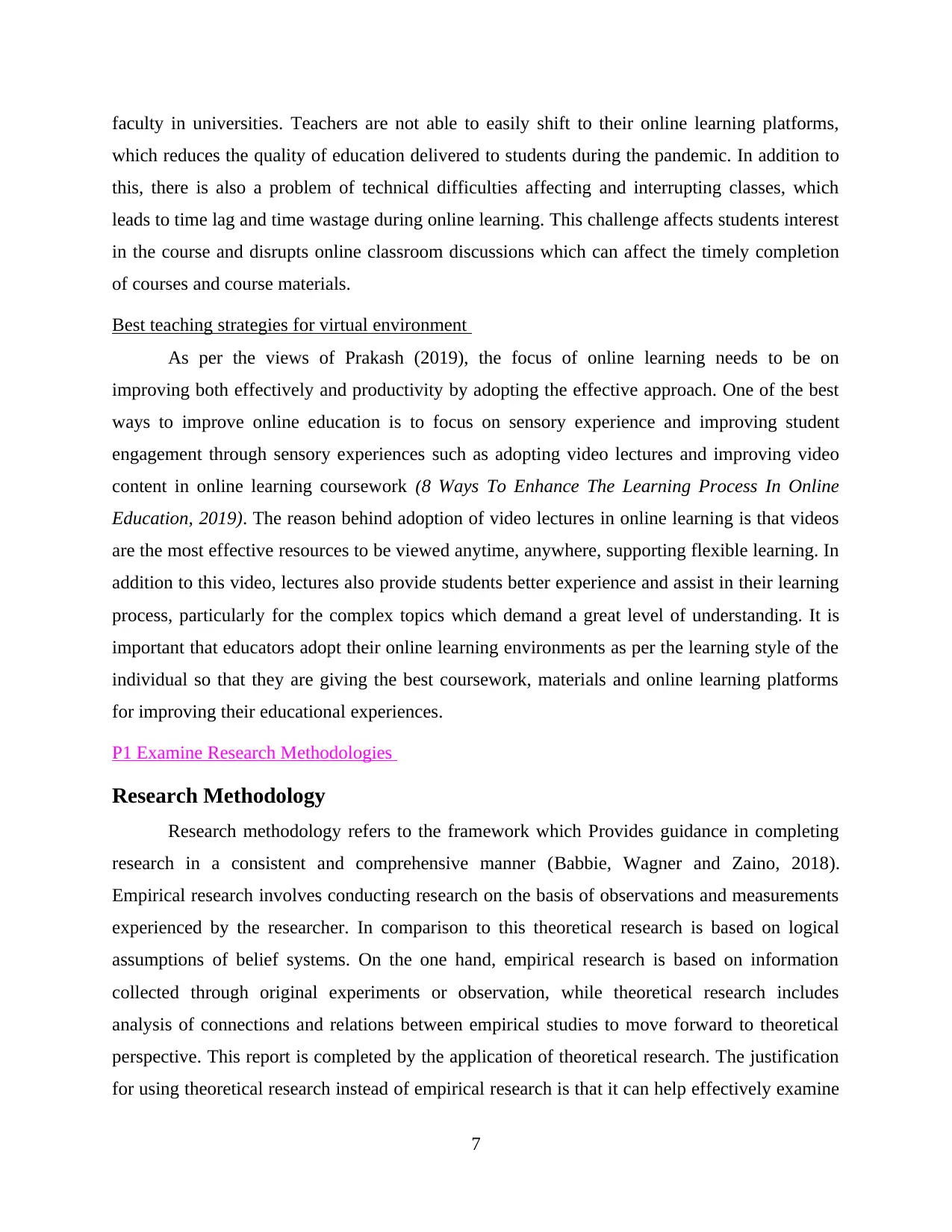
faculty in universities. Teachers are not able to easily shift to their online learning platforms,
which reduces the quality of education delivered to students during the pandemic. In addition to
this, there is also a problem of technical difficulties affecting and interrupting classes, which
leads to time lag and time wastage during online learning. This challenge affects students interest
in the course and disrupts online classroom discussions which can affect the timely completion
of courses and course materials.
Best teaching strategies for virtual environment
As per the views of Prakash (2019), the focus of online learning needs to be on
improving both effectively and productivity by adopting the effective approach. One of the best
ways to improve online education is to focus on sensory experience and improving student
engagement through sensory experiences such as adopting video lectures and improving video
content in online learning coursework (8 Ways To Enhance The Learning Process In Online
Education, 2019). The reason behind adoption of video lectures in online learning is that videos
are the most effective resources to be viewed anytime, anywhere, supporting flexible learning. In
addition to this video, lectures also provide students better experience and assist in their learning
process, particularly for the complex topics which demand a great level of understanding. It is
important that educators adopt their online learning environments as per the learning style of the
individual so that they are giving the best coursework, materials and online learning platforms
for improving their educational experiences.
P1 Examine Research Methodologies
Research Methodology
Research methodology refers to the framework which Provides guidance in completing
research in a consistent and comprehensive manner (Babbie, Wagner and Zaino, 2018).
Empirical research involves conducting research on the basis of observations and measurements
experienced by the researcher. In comparison to this theoretical research is based on logical
assumptions of belief systems. On the one hand, empirical research is based on information
collected through original experiments or observation, while theoretical research includes
analysis of connections and relations between empirical studies to move forward to theoretical
perspective. This report is completed by the application of theoretical research. The justification
for using theoretical research instead of empirical research is that it can help effectively examine
7
which reduces the quality of education delivered to students during the pandemic. In addition to
this, there is also a problem of technical difficulties affecting and interrupting classes, which
leads to time lag and time wastage during online learning. This challenge affects students interest
in the course and disrupts online classroom discussions which can affect the timely completion
of courses and course materials.
Best teaching strategies for virtual environment
As per the views of Prakash (2019), the focus of online learning needs to be on
improving both effectively and productivity by adopting the effective approach. One of the best
ways to improve online education is to focus on sensory experience and improving student
engagement through sensory experiences such as adopting video lectures and improving video
content in online learning coursework (8 Ways To Enhance The Learning Process In Online
Education, 2019). The reason behind adoption of video lectures in online learning is that videos
are the most effective resources to be viewed anytime, anywhere, supporting flexible learning. In
addition to this video, lectures also provide students better experience and assist in their learning
process, particularly for the complex topics which demand a great level of understanding. It is
important that educators adopt their online learning environments as per the learning style of the
individual so that they are giving the best coursework, materials and online learning platforms
for improving their educational experiences.
P1 Examine Research Methodologies
Research Methodology
Research methodology refers to the framework which Provides guidance in completing
research in a consistent and comprehensive manner (Babbie, Wagner and Zaino, 2018).
Empirical research involves conducting research on the basis of observations and measurements
experienced by the researcher. In comparison to this theoretical research is based on logical
assumptions of belief systems. On the one hand, empirical research is based on information
collected through original experiments or observation, while theoretical research includes
analysis of connections and relations between empirical studies to move forward to theoretical
perspective. This report is completed by the application of theoretical research. The justification
for using theoretical research instead of empirical research is that it can help effectively examine
7
Paraphrase This Document
Need a fresh take? Get an instant paraphrase of this document with our AI Paraphraser
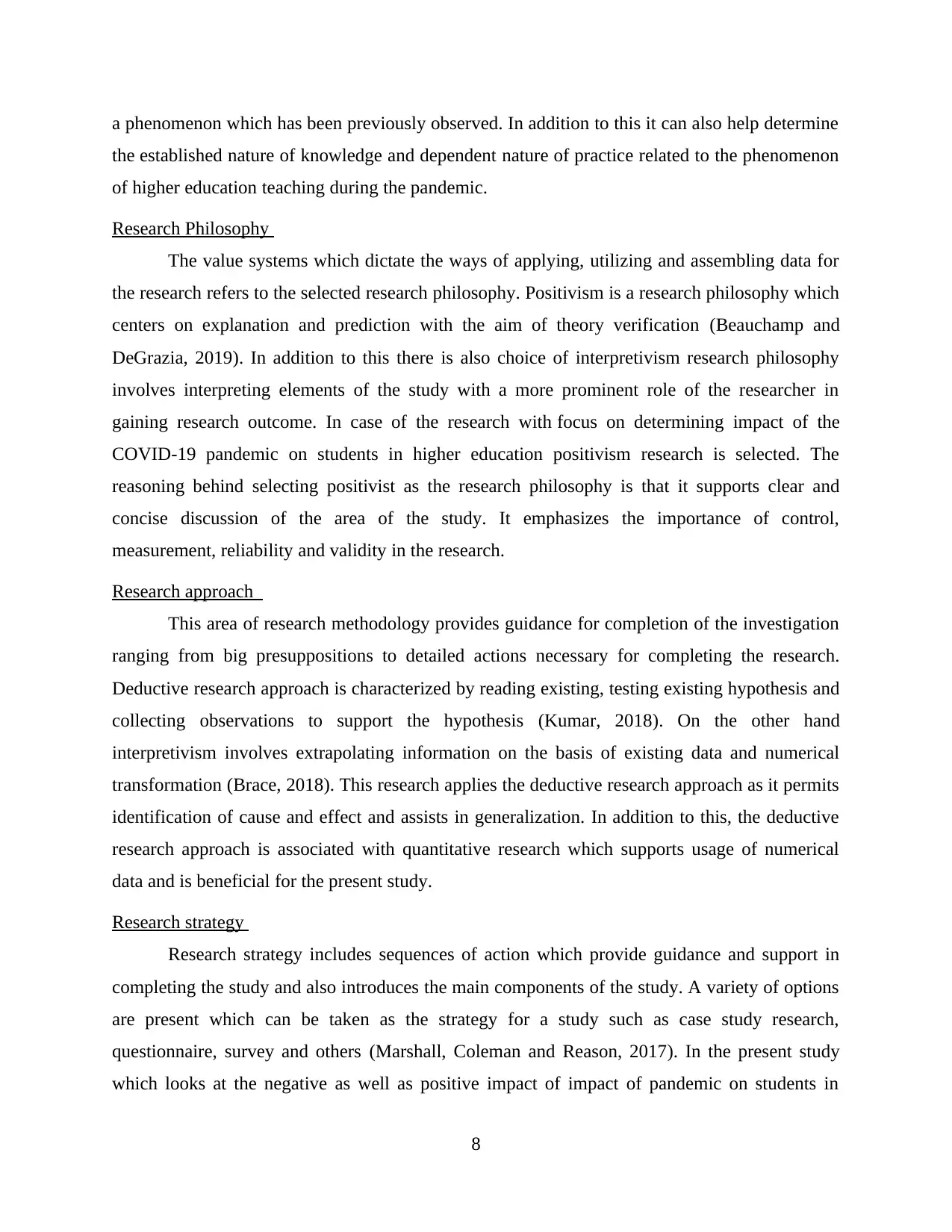
a phenomenon which has been previously observed. In addition to this it can also help determine
the established nature of knowledge and dependent nature of practice related to the phenomenon
of higher education teaching during the pandemic.
Research Philosophy
The value systems which dictate the ways of applying, utilizing and assembling data for
the research refers to the selected research philosophy. Positivism is a research philosophy which
centers on explanation and prediction with the aim of theory verification (Beauchamp and
DeGrazia, 2019). In addition to this there is also choice of interpretivism research philosophy
involves interpreting elements of the study with a more prominent role of the researcher in
gaining research outcome. In case of the research with focus on determining impact of the
COVID-19 pandemic on students in higher education positivism research is selected. The
reasoning behind selecting positivist as the research philosophy is that it supports clear and
concise discussion of the area of the study. It emphasizes the importance of control,
measurement, reliability and validity in the research.
Research approach
This area of research methodology provides guidance for completion of the investigation
ranging from big presuppositions to detailed actions necessary for completing the research.
Deductive research approach is characterized by reading existing, testing existing hypothesis and
collecting observations to support the hypothesis (Kumar, 2018). On the other hand
interpretivism involves extrapolating information on the basis of existing data and numerical
transformation (Brace, 2018). This research applies the deductive research approach as it permits
identification of cause and effect and assists in generalization. In addition to this, the deductive
research approach is associated with quantitative research which supports usage of numerical
data and is beneficial for the present study.
Research strategy
Research strategy includes sequences of action which provide guidance and support in
completing the study and also introduces the main components of the study. A variety of options
are present which can be taken as the strategy for a study such as case study research,
questionnaire, survey and others (Marshall, Coleman and Reason, 2017). In the present study
which looks at the negative as well as positive impact of impact of pandemic on students in
8
the established nature of knowledge and dependent nature of practice related to the phenomenon
of higher education teaching during the pandemic.
Research Philosophy
The value systems which dictate the ways of applying, utilizing and assembling data for
the research refers to the selected research philosophy. Positivism is a research philosophy which
centers on explanation and prediction with the aim of theory verification (Beauchamp and
DeGrazia, 2019). In addition to this there is also choice of interpretivism research philosophy
involves interpreting elements of the study with a more prominent role of the researcher in
gaining research outcome. In case of the research with focus on determining impact of the
COVID-19 pandemic on students in higher education positivism research is selected. The
reasoning behind selecting positivist as the research philosophy is that it supports clear and
concise discussion of the area of the study. It emphasizes the importance of control,
measurement, reliability and validity in the research.
Research approach
This area of research methodology provides guidance for completion of the investigation
ranging from big presuppositions to detailed actions necessary for completing the research.
Deductive research approach is characterized by reading existing, testing existing hypothesis and
collecting observations to support the hypothesis (Kumar, 2018). On the other hand
interpretivism involves extrapolating information on the basis of existing data and numerical
transformation (Brace, 2018). This research applies the deductive research approach as it permits
identification of cause and effect and assists in generalization. In addition to this, the deductive
research approach is associated with quantitative research which supports usage of numerical
data and is beneficial for the present study.
Research strategy
Research strategy includes sequences of action which provide guidance and support in
completing the study and also introduces the main components of the study. A variety of options
are present which can be taken as the strategy for a study such as case study research,
questionnaire, survey and others (Marshall, Coleman and Reason, 2017). In the present study
which looks at the negative as well as positive impact of impact of pandemic on students in
8
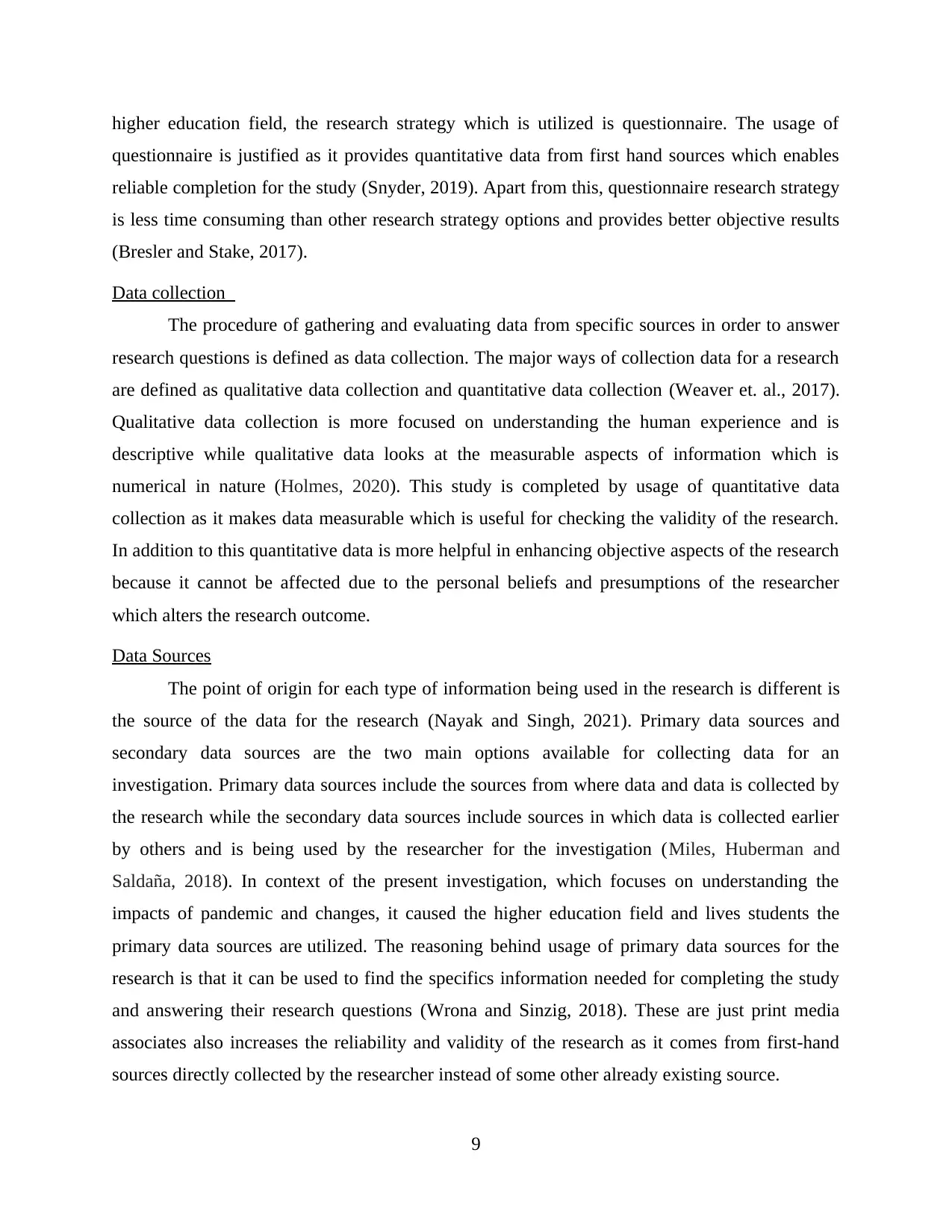
higher education field, the research strategy which is utilized is questionnaire. The usage of
questionnaire is justified as it provides quantitative data from first hand sources which enables
reliable completion for the study (Snyder, 2019). Apart from this, questionnaire research strategy
is less time consuming than other research strategy options and provides better objective results
(Bresler and Stake, 2017).
Data collection
The procedure of gathering and evaluating data from specific sources in order to answer
research questions is defined as data collection. The major ways of collection data for a research
are defined as qualitative data collection and quantitative data collection (Weaver et. al., 2017).
Qualitative data collection is more focused on understanding the human experience and is
descriptive while qualitative data looks at the measurable aspects of information which is
numerical in nature (Holmes, 2020). This study is completed by usage of quantitative data
collection as it makes data measurable which is useful for checking the validity of the research.
In addition to this quantitative data is more helpful in enhancing objective aspects of the research
because it cannot be affected due to the personal beliefs and presumptions of the researcher
which alters the research outcome.
Data Sources
The point of origin for each type of information being used in the research is different is
the source of the data for the research (Nayak and Singh, 2021). Primary data sources and
secondary data sources are the two main options available for collecting data for an
investigation. Primary data sources include the sources from where data and data is collected by
the research while the secondary data sources include sources in which data is collected earlier
by others and is being used by the researcher for the investigation (Miles, Huberman and
Saldaña, 2018). In context of the present investigation, which focuses on understanding the
impacts of pandemic and changes, it caused the higher education field and lives students the
primary data sources are utilized. The reasoning behind usage of primary data sources for the
research is that it can be used to find the specifics information needed for completing the study
and answering their research questions (Wrona and Sinzig, 2018). These are just print media
associates also increases the reliability and validity of the research as it comes from first-hand
sources directly collected by the researcher instead of some other already existing source.
9
questionnaire is justified as it provides quantitative data from first hand sources which enables
reliable completion for the study (Snyder, 2019). Apart from this, questionnaire research strategy
is less time consuming than other research strategy options and provides better objective results
(Bresler and Stake, 2017).
Data collection
The procedure of gathering and evaluating data from specific sources in order to answer
research questions is defined as data collection. The major ways of collection data for a research
are defined as qualitative data collection and quantitative data collection (Weaver et. al., 2017).
Qualitative data collection is more focused on understanding the human experience and is
descriptive while qualitative data looks at the measurable aspects of information which is
numerical in nature (Holmes, 2020). This study is completed by usage of quantitative data
collection as it makes data measurable which is useful for checking the validity of the research.
In addition to this quantitative data is more helpful in enhancing objective aspects of the research
because it cannot be affected due to the personal beliefs and presumptions of the researcher
which alters the research outcome.
Data Sources
The point of origin for each type of information being used in the research is different is
the source of the data for the research (Nayak and Singh, 2021). Primary data sources and
secondary data sources are the two main options available for collecting data for an
investigation. Primary data sources include the sources from where data and data is collected by
the research while the secondary data sources include sources in which data is collected earlier
by others and is being used by the researcher for the investigation (Miles, Huberman and
Saldaña, 2018). In context of the present investigation, which focuses on understanding the
impacts of pandemic and changes, it caused the higher education field and lives students the
primary data sources are utilized. The reasoning behind usage of primary data sources for the
research is that it can be used to find the specifics information needed for completing the study
and answering their research questions (Wrona and Sinzig, 2018). These are just print media
associates also increases the reliability and validity of the research as it comes from first-hand
sources directly collected by the researcher instead of some other already existing source.
9
⊘ This is a preview!⊘
Do you want full access?
Subscribe today to unlock all pages.

Trusted by 1+ million students worldwide
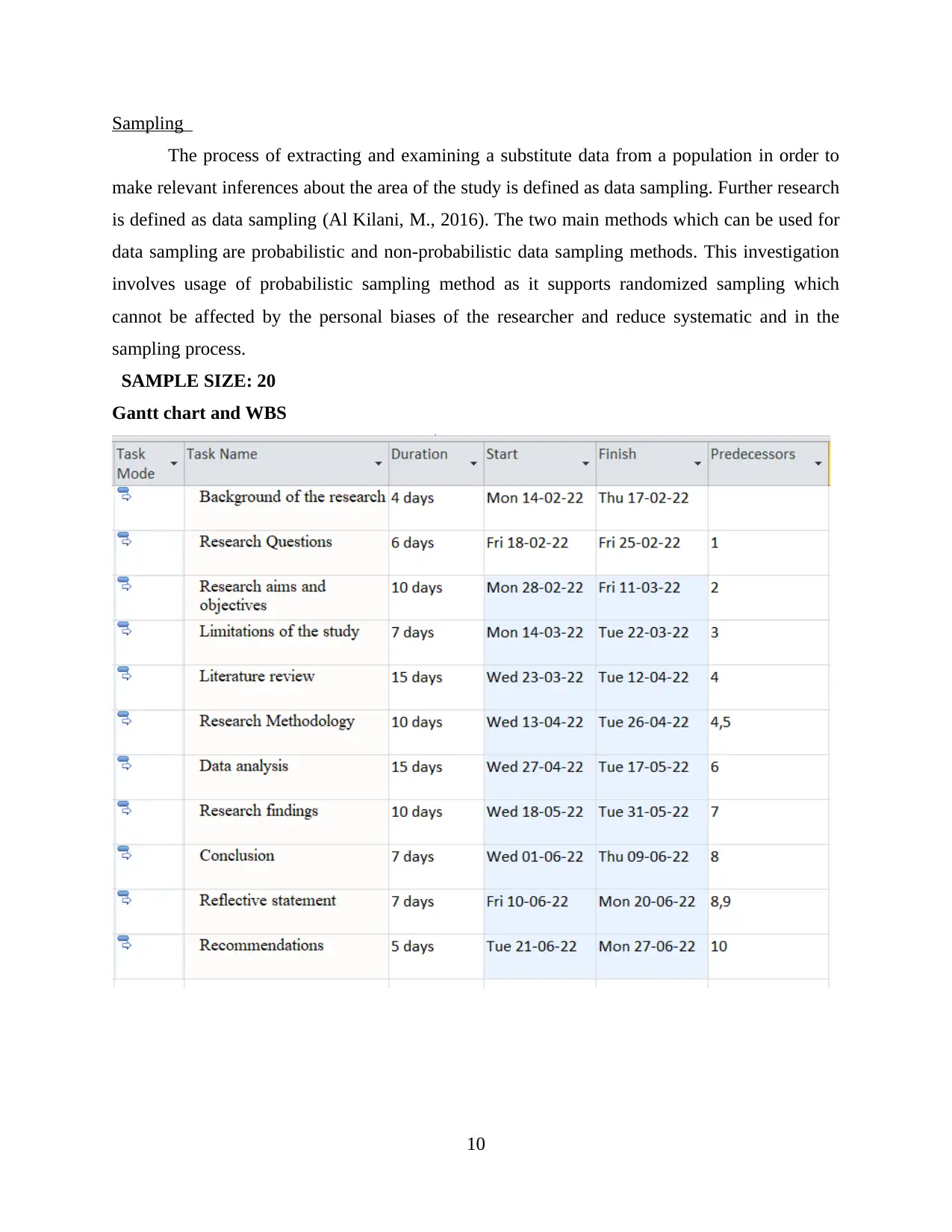
Sampling
The process of extracting and examining a substitute data from a population in order to
make relevant inferences about the area of the study is defined as data sampling. Further research
is defined as data sampling (Al Kilani, M., 2016). The two main methods which can be used for
data sampling are probabilistic and non-probabilistic data sampling methods. This investigation
involves usage of probabilistic sampling method as it supports randomized sampling which
cannot be affected by the personal biases of the researcher and reduce systematic and in the
sampling process.
SAMPLE SIZE: 20
Gantt chart and WBS
10
The process of extracting and examining a substitute data from a population in order to
make relevant inferences about the area of the study is defined as data sampling. Further research
is defined as data sampling (Al Kilani, M., 2016). The two main methods which can be used for
data sampling are probabilistic and non-probabilistic data sampling methods. This investigation
involves usage of probabilistic sampling method as it supports randomized sampling which
cannot be affected by the personal biases of the researcher and reduce systematic and in the
sampling process.
SAMPLE SIZE: 20
Gantt chart and WBS
10
Paraphrase This Document
Need a fresh take? Get an instant paraphrase of this document with our AI Paraphraser
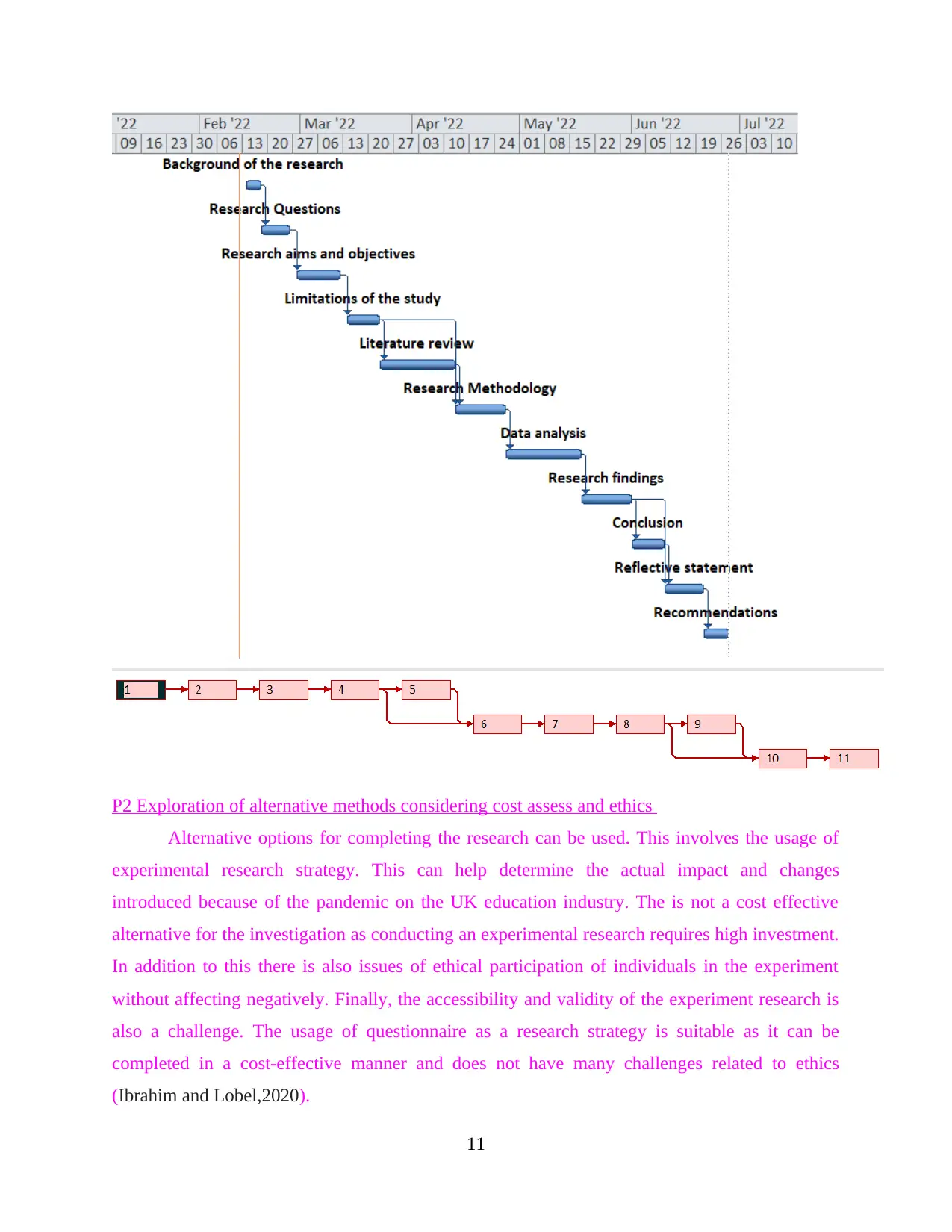
P2 Exploration of alternative methods considering cost assess and ethics
Alternative options for completing the research can be used. This involves the usage of
experimental research strategy. This can help determine the actual impact and changes
introduced because of the pandemic on the UK education industry. The is not a cost effective
alternative for the investigation as conducting an experimental research requires high investment.
In addition to this there is also issues of ethical participation of individuals in the experiment
without affecting negatively. Finally, the accessibility and validity of the experiment research is
also a challenge. The usage of questionnaire as a research strategy is suitable as it can be
completed in a cost-effective manner and does not have many challenges related to ethics
(Ibrahim and Lobel,2020).
11
Alternative options for completing the research can be used. This involves the usage of
experimental research strategy. This can help determine the actual impact and changes
introduced because of the pandemic on the UK education industry. The is not a cost effective
alternative for the investigation as conducting an experimental research requires high investment.
In addition to this there is also issues of ethical participation of individuals in the experiment
without affecting negatively. Finally, the accessibility and validity of the experiment research is
also a challenge. The usage of questionnaire as a research strategy is suitable as it can be
completed in a cost-effective manner and does not have many challenges related to ethics
(Ibrahim and Lobel,2020).
11
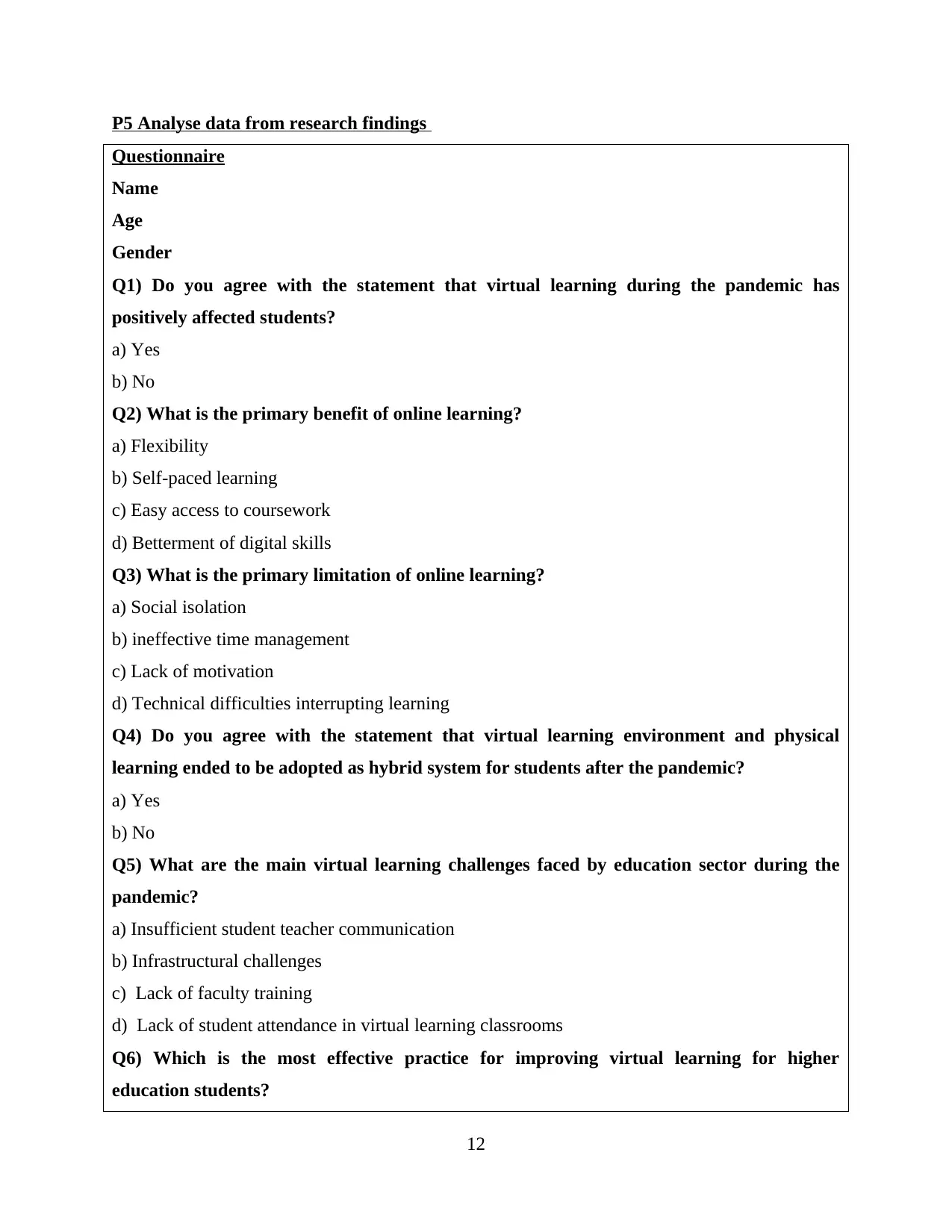
P5 Analyse data from research findings
Questionnaire
Name
Age
Gender
Q1) Do you agree with the statement that virtual learning during the pandemic has
positively affected students?
a) Yes
b) No
Q2) What is the primary benefit of online learning?
a) Flexibility
b) Self-paced learning
c) Easy access to coursework
d) Betterment of digital skills
Q3) What is the primary limitation of online learning?
a) Social isolation
b) ineffective time management
c) Lack of motivation
d) Technical difficulties interrupting learning
Q4) Do you agree with the statement that virtual learning environment and physical
learning ended to be adopted as hybrid system for students after the pandemic?
a) Yes
b) No
Q5) What are the main virtual learning challenges faced by education sector during the
pandemic?
a) Insufficient student teacher communication
b) Infrastructural challenges
c) Lack of faculty training
d) Lack of student attendance in virtual learning classrooms
Q6) Which is the most effective practice for improving virtual learning for higher
education students?
12
Questionnaire
Name
Age
Gender
Q1) Do you agree with the statement that virtual learning during the pandemic has
positively affected students?
a) Yes
b) No
Q2) What is the primary benefit of online learning?
a) Flexibility
b) Self-paced learning
c) Easy access to coursework
d) Betterment of digital skills
Q3) What is the primary limitation of online learning?
a) Social isolation
b) ineffective time management
c) Lack of motivation
d) Technical difficulties interrupting learning
Q4) Do you agree with the statement that virtual learning environment and physical
learning ended to be adopted as hybrid system for students after the pandemic?
a) Yes
b) No
Q5) What are the main virtual learning challenges faced by education sector during the
pandemic?
a) Insufficient student teacher communication
b) Infrastructural challenges
c) Lack of faculty training
d) Lack of student attendance in virtual learning classrooms
Q6) Which is the most effective practice for improving virtual learning for higher
education students?
12
⊘ This is a preview!⊘
Do you want full access?
Subscribe today to unlock all pages.

Trusted by 1+ million students worldwide
1 out of 32
Related Documents
Your All-in-One AI-Powered Toolkit for Academic Success.
+13062052269
info@desklib.com
Available 24*7 on WhatsApp / Email
![[object Object]](/_next/static/media/star-bottom.7253800d.svg)
Unlock your academic potential
Copyright © 2020–2025 A2Z Services. All Rights Reserved. Developed and managed by ZUCOL.





